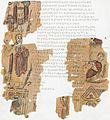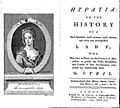Hypatia facts for kids
Quick facts for kids
Hypatia
|
|
|---|---|
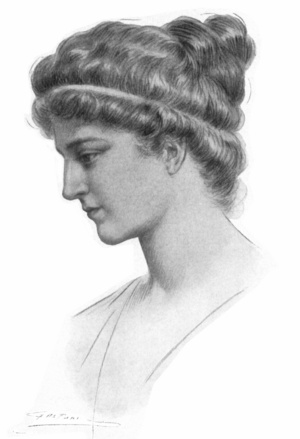
Fictional portrait of Hypatia
|
|
| Born | c. 350–370 AD |
| Died | March 415 AD (aged 45–65) Alexandria, Province of Egypt, Eastern Roman Empire
|
| Era | Ancient philosophy |
| Region | Western philosophy |
| School | Neoplatonism |
|
Main interests
|
|
|
Influences
|
|
|
Influenced
|
|
Hypatia (born around 350–370 AD; died 415 AD) was a famous philosopher, astronomer, and mathematician. She lived in Alexandria, Egypt, which was then part of the Eastern Roman Empire. Hypatia was well-known in her time as a wonderful teacher and a wise advisor.
Contents
Hypatia's Early Life and Family
Hypatia was the daughter of a mathematician named Theon of Alexandria. He lived from about 335 to 405 AD. Theon was in charge of a special school called the "Mouseion." This school was very important and highly respected.
Theon was seen as a great mathematician in his time. His most important work was creating a new version of Euclid's Elements. This book is about geometry. Theon fixed mistakes that had been made over almost 700 years of copying the book. His version of Euclid's Elements became the most used textbook for many centuries.
We don't know anything about Hypatia's mother. The exact year Hypatia was born is still debated by historians. Most likely, she was born around the year 370 AD.
Hypatia's Career and Teaching
Alexandria, Hypatia's home city, was a major center for learning and philosophy. Many people thought it was second only to Athens in importance. Hypatia taught students who came from all over the Mediterranean region. She gave lectures about the ideas of famous thinkers like Plato and Aristotle.
She would often walk through Alexandria wearing a tribon. This was a special cloak worn by philosophers. She would even give public lectures on the spot, sharing her knowledge with anyone who would listen.
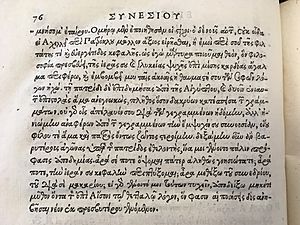
Hypatia was not a Christian, but she was very accepting of them. In fact, all of her known students were Christians. One of her most famous students was Synesius of Cyrene. He later became a bishop in a city called Ptolemais in 410 AD.
Another Christian historian, Philostorgius, who lived at the same time as Hypatia, said that she was even better at mathematics than her father. Ancient writings also describe Hypatia as being "exceedingly beautiful." However, we don't have any pictures or detailed descriptions of what she looked like.
Hypatia's Later Life and Death
Hypatia became very influential with important leaders in Alexandria. She was a trusted advisor.
Later in her life, Hypatia advised Orestes. He was the Roman governor of Alexandria. Orestes was having a disagreement with Cyril, who was the bishop of Alexandria. Some rumors started that Hypatia was stopping Orestes from making peace with Cyril.
In March 415 AD, Hypatia was attacked and killed by a group of Christians. Her death shocked the entire Roman Empire. She was called a "martyr for philosophy." Many people believed that Cyril had ordered her death, or that his actions had at least inspired it.
Hypatia's Contributions to Knowledge
Hypatia is often described as a very smart person who knew a lot about many subjects. However, she was probably more of a great teacher and a person who explained old texts, rather than someone who discovered completely new ideas. We don't have proof that she published her own philosophy books or made huge new math discoveries.
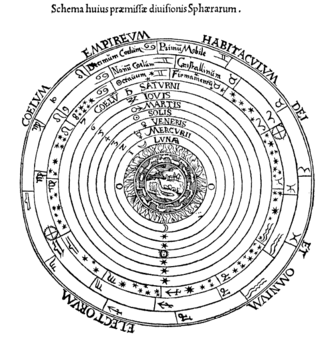
- Hypatia is known for editing Book III of Ptolemy's Almagest. This was an important book about astronomy. It's thought that she improved the way people did long division for astronomical calculations.
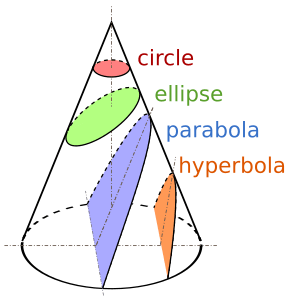
- She wrote notes on Diophantus's Arithmetica, a thirteen-volume math book from around 250 AD.
- Hypatia also wrote notes on Apollonius of Perga's work about conic sections. Sadly, these notes are now lost.
- She created an "Astronomical Canon." This might have been a new version of the Handy Tables by Ptolemy, or it could have been notes on his Almagest.
Interesting Facts About Hypatia
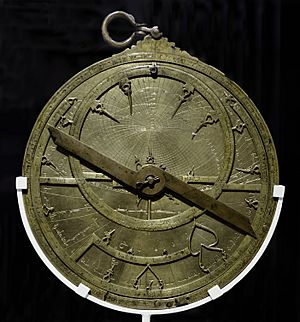
- Hypatia is the first female mathematician whose life story is well-recorded.
- She was a leading thinker in Alexandria, where she taught philosophy and astronomy.
- Many modern experts believe Hypatia also edited the remaining text of Ptolemy's Almagest.
- Hypatia built astrolabes and hydrometers. She didn't invent them, as they were used long before her time.
- She was very accepting of Christians and taught many Christian students.
- Old writings say that both pagans and Christians liked Hypatia very much.
- Scholars think she might have been part of the inspiration for the story of Saint Catherine of Alexandria.
- During the Age of Enlightenment, Hypatia became a symbol of standing up against the Catholic Church.
- In the 1900s, Hypatia became a symbol for women's rights.
- Hypatia never got married. She famously said she was "wedded to the truth."
Images for kids
-
Drawing from the Alexandrian World Chronicle showing Pope Theophilus of Alexandria standing on the Serapeum in 391 AD.
-
An icon of Saint Catherine of Alexandria from Saint Catherine's Monastery in Sinai, Egypt. Her story might have been partly inspired by Hypatia.
-
The 18th-century scholar John Toland used Hypatia's death to write against the Catholic Church. He changed some details to make Cyril look worse.
See also
 In Spanish: Hipatia para niños
In Spanish: Hipatia para niños



